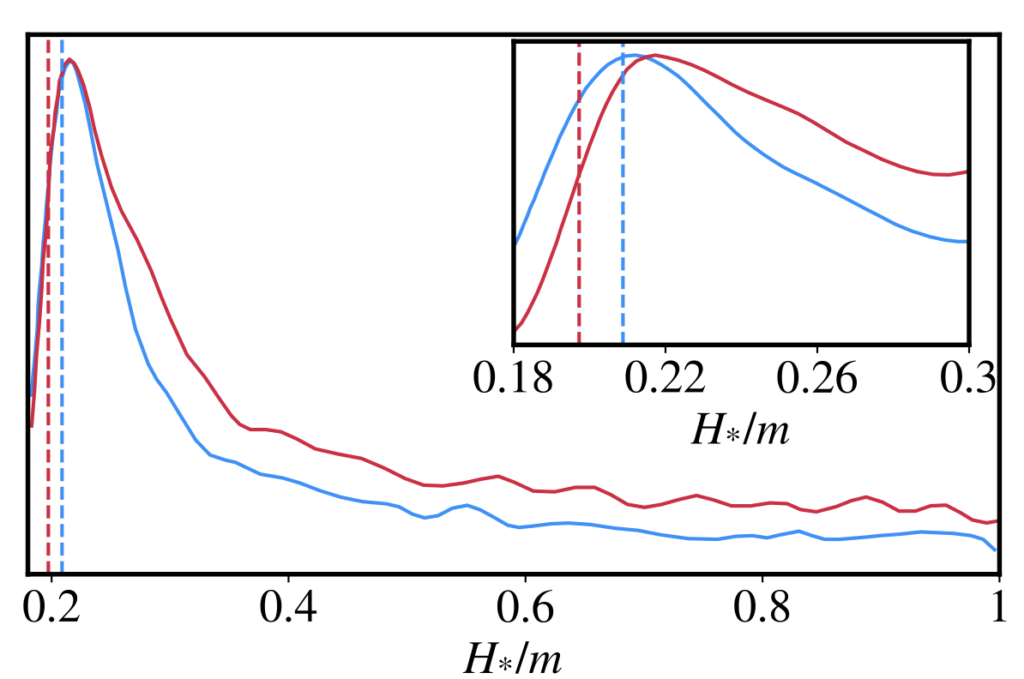In a new paper “we explore the possibility that exotic forms of dark matter could expose humans on Earth or on prolonged space travel to a significant radiation dose. The radiation exposure from dark matter interacting with nuclei in the human body is generally assumed to be negligible compared to other sources of background radiation. However, as we discuss here, current data allow for dark matter models where this is not necessarily true”. See: https://arxiv.org/abs/2411.10521
Author Archives: admin
New distance-ladder independent measurement using type II SN finds H0 = 74.9 \pm 1.9 (stat) km/s/Mpc in consistency with SH0ES and further confirming the Hubble tension: https://arxiv.org/abs/2411.04968
In a new paper with Aleksandr Chatrchyan, Florian Niedermann, and Vivian Poulin (https://arxiv.org/abs/2408.14537), we generalize the treatment of the NEDE fluid in the Cold NEDE model and test it against updated CMB and Supernovae data. We show that in the Cold NEDE model, the NEDE fluid can, as previously anticipated, be described as a mix of stiff fluid and radiation consistently with data.
The new CMB Planck NPIPE data and Pantheon+ supernova data slightly increase the tension between ΛCDM and SH0ES. This similarly slightly increases the residual tension in (N)EDE models when relieving the Hubble tension, with Cold NEDE doing slightly better than AxiEDE and other EDE-type models. On the other hand, we know from other studies that the recent DESI data pulls in the opposite direction toward reducing the residual tension by a similar amount. In conclusion, further improvements in data and NEDE model building provide a constructive and promising way forward.
Finally, we have made a non-trivial test of the Cold NEDE model. In the Cold NEDE model, it is a theoretical prediction that the ratio between the Hubble rate at the time of the phase transition, H*, and the mass of the trigger field, m, should satisfy H*/m ~ 0.2. Being agnostic about the underlying model and fitting H* and m as free parameters to the data is a way of testing this specific prediction of Cold NEDE. It is spectacular that we find a peak in the probability distribution for H*/m between 0.20 and 0.22 as predicted (see figure below).

Two new analyses of the Hubble tension are based solely on data from the JWST telescope and serve as a check of the measurements using the Hubble Space Telescope (HST), which initially led to the tension in the first place. In the paper today (https://arxiv.org/abs/2408.11770), a value of H0 of 72.6 plus-minus 2.0 km/s/Mpc using JWST data alone is reported. This is also consistent with previous values reported by SH0ES using HST data and consistent with the slightly lower values reported by the CCHP team in another analysis based on JWST data alone (https://arxiv.org/abs/2408.06153) when accounting for the smaller subsample of supernovae used by CCHP. Restricting their analysis to the same smaller subsample as used by CCHP, the SH0ES team reproduces their values, a strong indication of overall agreement. It seems we are very close to a confirmation of the Hubble tension independent from the original HST data.

Figure from Riess et. al. 2024 [2408.11770]
New paper with Mathias Garny, Florian Niedermann, and Henrique Rubira. We show that Hot NEDE provides a UV completion of SIDR and stepped models, bringing them in agreement with the BBN constraints when addressing the Hubble tension: https://arxiv.org/abs/2404.07256

Exciting new results from DESI today on the large-scale structure of the universe and the measurement of baryonic acoustic oscillations (BAO). The first takeaway relating to New Early Dark Energy (NEDE) as a solution to the Hubble tension is the product of the drag-epoch sound horizon and the scaled Hubble constant of rdh = (101.8 ± 1.3) Mpc, slightly higher than previous measurements.
This might mean that one needs a smaller reduction of the sound horizon to achieve the same increase of H0—as illustrated by superimposing (by eye on the iPad) the constraint on the plot of Know and Millea from 2019 below — making it marginally easier to resolve the Hubble tension within NEDE.

Opportunity for advanced post-doc level researchers to set up their own group in Denmark (see below). If you work within the (one of the) fields of particle physics, cosmology, astroparticle, (quantum-) gravity, or astronomy, feel free to contact me directly.
https://villumfonden.dk/en/group/grantsubarea/villum-young-investigator
An interview with me about the origin of the Universe and Dark Energy was aired today on Danish Radio4. We also got to talk about, among others, the Hubble tension and New Early Dark Energy (NEDE). Below is a link to the full interview (in Danish).
”LIVET: Sådan blev universet skabt” blev sendt kl. 12.10 til 13.00 på Radio4 d. 25. december: https://radio4.dk/podcasts/kraniebrud/livet-s-dan-blev-universet-skabt

An interesting paper from this morning, https://arxiv.org/abs/2312.11074, points out that (N)EDE-type models could potentially also resolve the problem of early galaxy formation found by JWST, as was also hinted at in a previous study https://arxiv.org/abs/2208.01611. The authors point out that the region of (N)EDE parameter space required for solving the JWST problem is the same region of (N)EDE parameter space needed for solving the H0 tension.
Check out the excellent talk by my collaborator, Florian Niedermann, on New Early Dark Energy (NEDE) in the CosmoVerse seminar series linked below.
